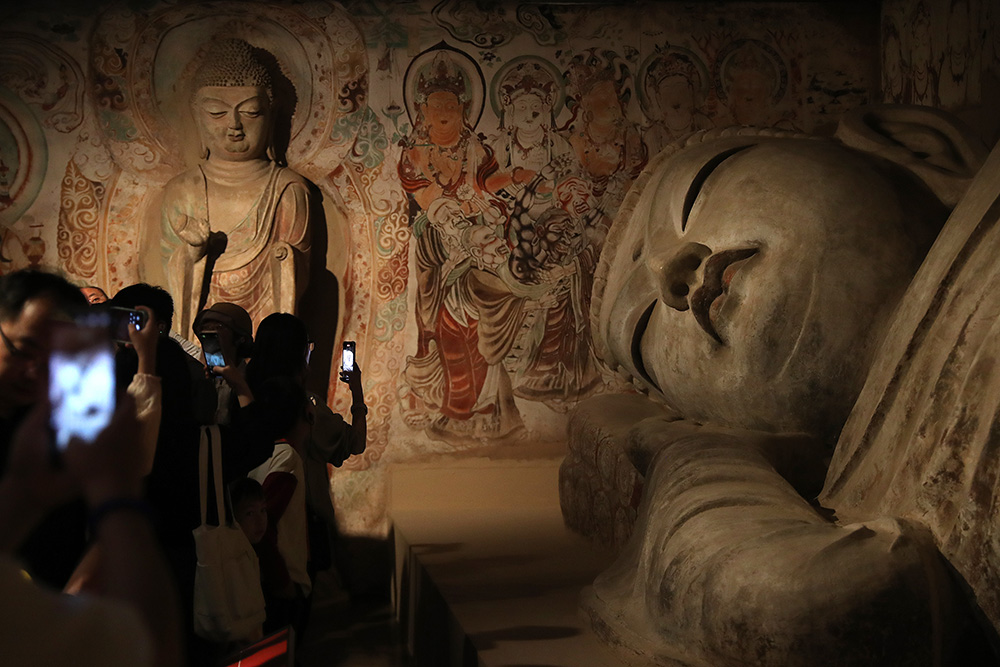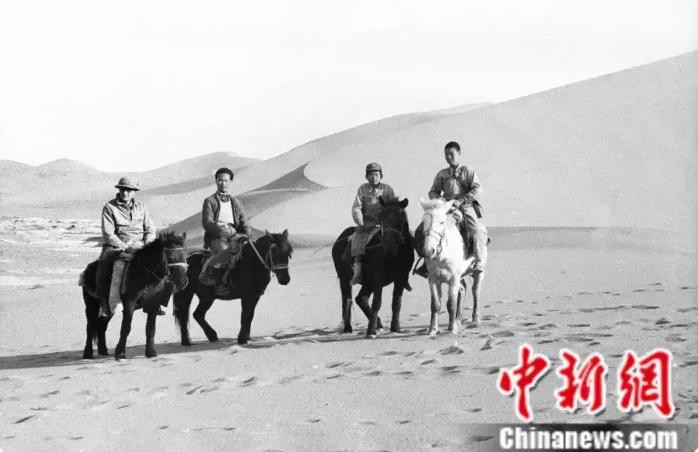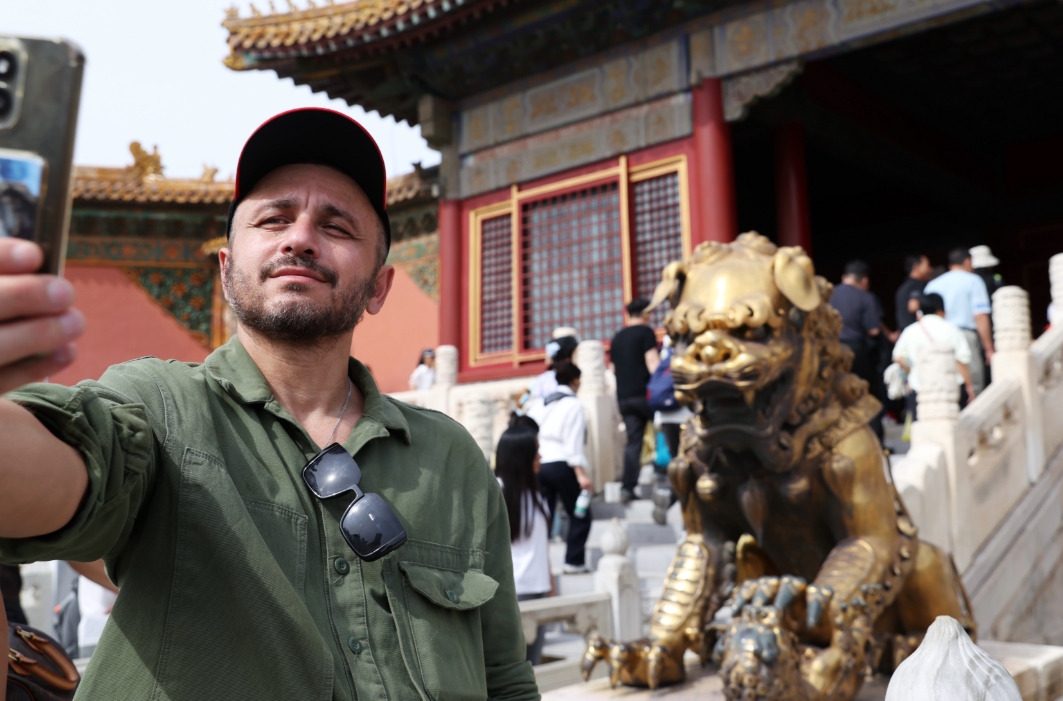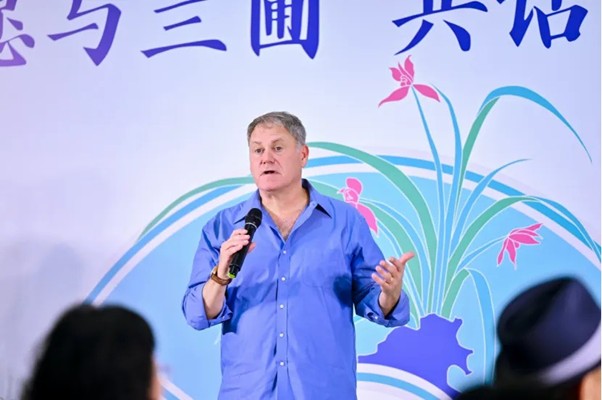Buddhism was introduced into China during the Han dynasty, and since then, it has been continuously absorbing Chinese local cultural ideology and gradually developing into a religious and cultural form with Chinese characteristics, and continuously building bridges between different cultures and regions.
From the Sui and Tang dynasties onwards, China gradually gained an important position for spreading Buddhism abroad. What contributions has China made to the development of mutual learning and cultural development among different countries? What inspirations we can get from Buddhism’s integration into China for Buddhist cultural exchanges in today’s world? What cognitive consensus and practical advocacy can the Chinese and foreign Buddhist communities provide to promote peaceful coexistence and win-win cooperation in the world, and to promote cultural exchanges and people-to-people communication? Prof. Zhang Fenglei, director of the Institute of Buddhism and Religious Theory of Renmin University of China, recently received an exclusive interview by CNS to interpret the above questions.
Here are the excerpts of the interview:
CNS: In your opinion, what stages did the Sinification of Buddhism go through in Chinese history? How did Buddhism absorb Daoism and Confucianism of China and eventually become a religious and cultural form with Chinese characteristics?
Zhang Fenglei: Buddhism arose in ancient India from the 6th to 5th centuries B.C.E., and was introduced to China at the time of the Han Dynasty, thus beginning the course of Sinification. It can be said that the entire history of Chinese Buddhism is a history of the Sinification of Buddhism.
Tang Yongtong, a leading researcher of Chinese Buddhism, divided the history of the introduction of Buddhism into China and its conflict and integration with the inherent Chinese culture into three stages.
In the first stage, when Buddhism was first introduced into China, it was “reconciled by seeing similarities on the surface”. This stage was called the stage of Buddhist alchemization, when Chinese understanding of Buddhist beliefs was similar to their understanding of local alchemy and mystical arts. In terms of ideology, Buddhism is similar to the school of Huanglao (黄老之学), which advocates emptiness and inaction. In terms of cultivation methods, Buddhism’s promotion of Mindfulness of Inhalation and Exhalation (Anban Shouyi,安般守意) is close to the methods used in the mystical arts in China.
In the second stage, when Buddhism spread more deeply, “conflicts raised due to differences seen”. For example, orthodox Confucian scholars criticized Buddhist monks for “shaving off their hair and beard and relinquish family life”, which was against the saying in the Classic of Filial Piety, “The body, hair, and skin are the received from one’s parents, and one dare not destroy them.” Monks who do not marry or have children also go against the saying in Mencius, “There are three unfilial things, not to have a child is the first one.” This kind of criticism implies that there is a serious conflict between the foreign Buddhism and the local Chinese core values of filial piety and fraternal duty.
As another example, in order to make it easier for Chinese to understand Buddhist concepts and ideas, in the process of translating, preaching, and interpreting the scriptures, the method of Geyi (格义), or parallel-conceptualization was adopted, that is, using the concepts, terms, and ideas of Confucianism, Daoism, and Xuanxue (玄学) that were familiar to the Chinese people to explain the names and ideas of Buddhism. “Nirvana” (涅槃) was first translated into “inaction”(无为), and Emptiness(性空)was as Nothingness(本无). The term Selflessness(无我)was translated as Non-Self(非身), which means that the Indian Buddhist terminology was transformed into conceptual terms that the Chinese could understand. In this way, some similar concepts, terms, and ideas from Confucianism, Daoism, Xuanxue, and other indigenous cultures were introduced into Buddhism. Geyi also caused reflection and criticism by Buddhist scholars in the Eastern Jin Dynasty, such as Master Daoan, who believed that Geyi always causes misconception, and his disciple, Sengrui, who also criticized Geyi as pedantic and deviating from the true ideas and that such a method was not in accordance with the original principles resulting in misunderstanding in concept, terminology and theory. However, such misunderstanding was natural and unavoidable, but from an objective point of view, also promoted the exchange and fusion of foreign and local thought and culture.
The third stage is “reconciled through the discovery of true harmony”. As mentioned above, although there are various differences and conflicts(sometimes even serious ones) in the contact and collision between Buddhism and Chinese local ideology and culture, overall, the mainstream trend and basic laws of Buddhism’s dissemination and development in China are still striving to adapt and harmonize with China’s mainstream politics, economy, ideology, culture, and society. This is an important characteristic of the Sinification of Buddhism.
For example, in the face of the accusation that Buddhist monasticism is contrary to Confucian filial piety, the Buddhist Protectorate Literature, represented by the Master Mou’s Treatise Dispelling Doubts (《牟子理惑论》) does not deliberately emphasize the differences between Buddhism and Chinese native ideology and culture. Instead, it used examples such as “although Taibo had his hair cut and body tattooed, Confucius still called him the highest virtue” to vigorously argue that Buddhism not only did not violate the core values of Chinese local values represented by Confucianism and Daoism, but also practiced Chinese local values through similar behaviors adopted by ancient Chinese sages, maintaining that Buddhism follows filial piety in a higher dimension, by explaining the rationality of differences through the words and deeds of ancient sages recognized by Confucianism, thus resolving conflicts and contradictions with Chinese local culture. In addition, in terms of the relationship between politics and religion, Buddhism has realized that “without following the ruler, it is difficult to promote Buddhism”, therefore, the recognition of Chinese state power had gradually become a tradition.
In fact, these stages of the Sinification of Buddhism were not sharply divided from each other; the whole was a process of gradual development, constant conflict and reconciliation. Chinese monks were familiar with Confucianism and Daoism before they came into contact with Buddhism, and their understanding of Buddhism was naturally colored by Chinese culture. Many Buddhist scriptures were gradually absorbed into Chinese culture after they were introduced to China, and also adapted to local mainstream Chinese values such as filial piety.
CNS: Since the Sui and Tang dynasties, China has gradually become an important place for spreading Buddhism to the outside world. For thousands of years, the Chinese people have spread Buddhism to Japan, the Korean peninsula, Southeast Asia, and other areas. what kind of contribution has it brought to the cultural exchanges and mutual learning among countries?
Zhang Fenglei: Cultural exchange and mutual learning is a two-way street. As early as the Southern and Northern Dynasties, Buddhism began to spread from China to Japan, the Korean Peninsula, and other places, and gradually developed into an organized and large-scale cultural exchange in the Tang Dynasty, represented by Jianzhen’s voyage to Japan.
Tracing back to their roots, most of the major Buddhist sects in Japan and the Korean Peninsula originated in China. After these Buddhist sects were imported, they profoundly influenced local politics, culture, and art, and had a very far-reaching impact on calligraphy, architecture, tea culture, and costume. In the late Ming Dynasty, Chan Master Yinyuan was invited to Japan to propagate Dharma and found the Obaku School(Huangbo Zong, 黄檗宗), one of the three major schools of Japanese Zen. Today, Mount Huangbo in Fujian, China still maintains very close exchanges with the Buddhist community in Japan.
Overall, China’s influence plays a dominant role, but sometimes China also benefits from it. For example, many Buddhist scriptures lost in China have been retrieved in Japan or the Korean Peninsula, playing a great role in continuing China’s sects.
In addition, Buddhism not only spread from India and the Western Regions (西域) to China but also formed a back-flow of cultural communication. Master Xuanzang translated both the Buddhist scriptures into China and Chinese classics such as the Daode Jing(Tao Te Ching,《道德经》)into India. According to research, there is also a history of scriptures written by Chinese, full of absorption of Yin and Yang, Five Elements and Daoist thought, introduced back to the West or India, and then translated back into China.
CNS: What can we learn from the integration of Buddhism into Chinese history provide for the development of Buddhist cultural exchanges between China and other countries today?
Zhang Fenglei: While Buddhism was introduced to the Chinese mainland at the time of the Han Dynasty and at the beginning of the first half of the second century B.C.E., it continued uninterruptedly after the middle of the second century, when sectarian Buddhism continued to develop in India and the Western Regions, and Mahayana Buddhism also flourished. During this period, China’s indigenous scripture study was well developed, and later Xuanxue also began to flourish. When heterogeneous cultures of comparable size, scale, and maturity come into contact with each other, there is a parallel situation of conflict and convergence.
The peaceful development of Buddhism in China is partly related to the fact that Buddhism itself does not seek a dominant position in its cultural psyche, and partly due to the inclusiveness of Chinese culture. The Middle Way (non-duality, 中道), as a fundamental concept of Buddhism, was mainly critical in the early days, but in China, it gradually absorbed Confucianism and other ideologies and cultures, and developed into the spirit of harmony in the Middle Way, which switched its meaning for more tolerance, thus providing inspirations for the exchange and mutual learning of human cultures.
Despite the emergence of anti-globalization trend, the mainstream of globalization will not change. Cultural exchanges and mutual learning should be carried out in a peaceful manner, on the premise of a peaceful development environment. Only when the world upholds the concept of a community with a shared future for mankind, cooperating diversely and developing together, can cultures exchange and learn from each other in a peaceful manner and with an open mind.
CNS: The theme of this year’s World Buddhist Forum is “Hand in Hand for Coexistence”. In the context of the accelerated evolution of the world’s unprecedented changes, what cognitive consensus and practical recommendations can the Buddhist communities provide for promoting peaceful coexistence and win-win cooperation in the world, promoting cultural exchanges and people-to-people communication, and actively contributing to the building of a community of shared future?
Zhang Fenglei: Buddhist cultural concepts, especially many of the basic concepts of Chinese Buddhism, are based on the idea of “conditioned origination”, that everything is conditional, rather than self-contained, which contains the meaning of harmony and coexistence. When Buddhism came to China, the idea shifted from “breaking” to “establishing”, which is more inclusive and harmonious, laying an important ideological foundation for building a community with a shared future for mankind.
The theme of this year’s World Buddhist Forum – Hand in Hand for Coexistence – holds the fundamental spirit of Buddhism. It is only when we work towards Harmony and Coexistence and the building of a community of human destiny in our thoughts and actions that we can turn our thoughts and spirit into real social power. The direction of historical development consists of cooperative forces. When we form a consensus and make joint efforts in the direction of harmony and coexistence, the development of human history may move more in the direction of peace and tolerance, and the possibility of realizing the community of human destiny will become greater.
Cultural acceptance is also important. As part of the non-governmental contacts, academic exchanges lay the doctrinal foundation for building a cultural community. Historically, cultural interactions among China, Japan, and the Korean peninsula, including Buddhism, Confucianism, and Daoism, have actually formed a cultural community with Chinese culture as its base and the distinctive features of each of China, Japan, and the Korean peninsula. This common East Asian cultural foundation provides a solid historical background for the construction of the contemporary community of human destiny.
Written by Xu Xueying from CNS
If you liked this article, why not read: Take a “high-five with the Buddha” selfie @Yungang Grottoes











